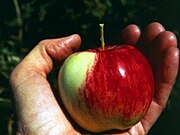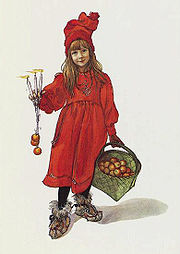| Apple | ||||||||||||||||||
|---|---|---|---|---|---|---|---|---|---|---|---|---|---|---|---|---|---|---|
 Blossoms, fruits, and leaves of the apple tree (Malus domestica) | ||||||||||||||||||
| Scientific classification | ||||||||||||||||||
| ||||||||||||||||||
| Binomial name | ||||||||||||||||||
| Malus domestica Borkh. |
The apple is the pomaceous fruit of the apple tree, species Malus domestica in the rose family Rosaceae. It is one of the most widely cultivated tree fruits. The tree is small and deciduous, reaching 3 to 12 metres (9.8 to 39 ft) tall, with a broad, often densely twiggy crown.[1] The leaves are alternately arranged simple ovals 5 to 12 cm long and 3–6 centimetres (1.2–2.4 in) broad on a 2 to 5 centimetres (0.79 to 2.0 in) petiole with an acute tip, serrated margin and a slightly downy underside. Blossoms are produced in spring simultaneously with the budding of the leaves. The flowers are white with a pink tinge that gradually fades, five petaled, and 2.5 to 3.5 centimetres (0.98 to 1.4 in) in diameter. The fruit matures in autumn, and is typically 5 to 9 centimetres (2.0 to 3.5 in) diameter. The center of the fruit contains five carpels arranged in a five-point star, each carpel containing one to three seeds.[1]
The tree originated from Central Asia, where its wild ancestor is still found today. There are more than 7,500 known cultivars of apples resulting in range of desired characteristics. Cultivars vary in their yield and the ultimate size of the tree, even when grown on the same rootstock.[2]
At least 55 million tonnes of apples were grown worldwide in 2005, with a value of about $10 billion. China produced about 35% of this total.[3] The United States is the second leading producer, with more than 7.5% of the world production. Turkey, France, Italy and Iran are also among the leading apple exporters.
Botanical information

The wild ancestor of Malus domestica is Malus sieversii, which is found growing wild in the mountains of Central Asia in southern Kazakhstan, Kyrgyzstan, Tajikistan, and Xinjiang, China.[4]
History
- See also: Herefordshire Pomona
The center of diversity of the genus Malus is the eastern Turkey. The apple tree was perhaps the earliest tree to be cultivated,[5] and its fruits have been improved through selection over thousands of years. Alexander the Great is credited with finding dwarfed apples in Asia Minor in 300 BCE;[1] those he brought back to Macedonia might have been the progenitors of dwarfing rootstocks. Winter apples, picked in late autumn and stored just above freezing, have been an important food in Asia and Europe for millennia, as well as in Argentina and in the United States since the arrival of Europeans.[5] Apples were brought to North America with colonists in the 1600s,[1] and the first apple orchard on the North American continent was said to be near Boston in 1625. In the 1900s, irrigation projects in Washington state began and allowed the development of the multi-billion dollar fruit industry, of which the apple is the leading species.[1]
Cultural aspects
Germanic paganism

In Norse mythology, the goddess Iðunn is portrayed in the Prose Edda (written in the 13th century by Snorri Sturluson) as providing apples to the gods that give them eternal youthfulness. English scholar H. R. Ellis Davidson links apples to religious practices in Germanic paganism, from which Norse paganism developed. She points out that buckets of apples were found in the Oseberg ship burial site in Norway and that fruit and nuts (Iðunn having been described as being transformed into a nut in Skáldskaparmál) have been found in the early graves of the Germanic peoples in England and elsewhere on the continent of Europe which may have had a symbolic meaning, and that nuts are still a recognized symbol of fertility in Southwest England.[6]
Davidson notes a connection between apples and the Vanir, a tribe of gods associated with fertility in Norse mythology, citing an instance of eleven "golden apples" being given to woo the beautiful Gerðr by Skírnir, who was acting as messenger for the major Vanir god Freyr in stanzas 19 and 20 of Skírnismál. Davidson also notes a further connection between fertility and apples in Norse mythology in chapter 2 of the Völsunga saga when the major goddess Frigg sends King Rerir an apple after he prays to Odin for a child, Frigg's messenger (in the guise of a crow) drops the apple in his lap as he sits atop a mound.[7] Rerir's wife's consumption of the apple results in a six-year pregnancy and the caesarean section birth of their son - the hero Völsung.[8]
Further, Davidson points out the "strange" phrase "Apples of Hel" used in an 11th-century poem by the skald Thorbiorn Brúnarson, she states this may imply that the apple was thought of by the skald as the food of the dead. Further, Davidson notes that the potentially Germanic goddess Nehalennia is sometimes depicted with apples and that parallels exist in early Irish stories. Davidson asserts that while cultivation of the apple in Northern Europe extends back to at least the time of the Roman Empire and came to Europe from the Near East, the native varieties of apple trees growing in Northern Europe are small and bitter. Davidson concludes that in the figure of Iðunn "we must have a dim reflection of an old symbol: that of the guardian goddess of the life-giving fruit of the other world."
Tidak ada komentar:
Posting Komentar